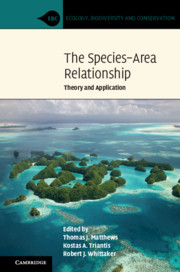Book contents
- The Species–Area Relationship
- Ecology, Biodiversity and Conservation
- The Species–Area Relationship
- Copyright page
- Contents
- Contributors
- Foreword
- Preface
- Part I Introduction and History
- Part II Diversity–Area Relationships: The Different Types and Underlying Factors
- Part III Theoretical Advances in Species–Area Relationship Research
- Part IV The Species–Area Relationship in Applied Ecology
- 13 The Identification of Biodiversity Hotspots Using the Species–Area Relationship
- 14 Using the Species–Area Relationship to Predict Extinctions Resulting from Habitat Loss
- 15 Using Network Analysis to Explore the Role of Dispersal in Producing and Maintaining Island Species–Area Relationships
- 16 Does Geometry Dominate Extinction due to Habitat Loss?
- 17 Using Relict Species–Area Relationships to Estimate the Conservation Value of Reservoir Islands to Improve Environmental Impact Assessments of Dams
- 18 An Investigation of Species–Area Relationships in Marine Systems at Large Spatial Scales
- Part V Future Directions in Species–Area Relationship Research
- Index
- References
17 - Using Relict Species–Area Relationships to Estimate the Conservation Value of Reservoir Islands to Improve Environmental Impact Assessments of Dams
from Part IV - The Species–Area Relationship in Applied Ecology
Published online by Cambridge University Press: 11 March 2021
- The Species–Area Relationship
- Ecology, Biodiversity and Conservation
- The Species–Area Relationship
- Copyright page
- Contents
- Contributors
- Foreword
- Preface
- Part I Introduction and History
- Part II Diversity–Area Relationships: The Different Types and Underlying Factors
- Part III Theoretical Advances in Species–Area Relationship Research
- Part IV The Species–Area Relationship in Applied Ecology
- 13 The Identification of Biodiversity Hotspots Using the Species–Area Relationship
- 14 Using the Species–Area Relationship to Predict Extinctions Resulting from Habitat Loss
- 15 Using Network Analysis to Explore the Role of Dispersal in Producing and Maintaining Island Species–Area Relationships
- 16 Does Geometry Dominate Extinction due to Habitat Loss?
- 17 Using Relict Species–Area Relationships to Estimate the Conservation Value of Reservoir Islands to Improve Environmental Impact Assessments of Dams
- 18 An Investigation of Species–Area Relationships in Marine Systems at Large Spatial Scales
- Part V Future Directions in Species–Area Relationship Research
- Index
- References
Summary
Large dams are emerging drivers of landscape-scale habitat fragmentation, causing extensive flooding and transforming hilltops into islands. Environmental Impact Assessments (EIAs; the process to assess and account for impacts of development) do not explicitly consider reservoir islands in calculations of habitat impacted by dam construction. Reservoir islands maintain relict biological communities from the previously continuous habitat. Relict communities are subject to an extinction debt whereby species are lost over time. We demonstrate how estimating the ‘conservation value’ of islands (CV; the proportion of relict continuous habitat [forest] species on islands) using relict species–area relationships (RSARs), can be used in an area-of-impact correction tool to account for insular habitats in EIAs. We used data from eight taxonomic groups within the Balbina Hydroelectric Reservoir (BHR) archipelago in Brazilian Amazonia. We found ca. 72,000 ha of insular habitat had reduced CV, equating to 60% of aggregate island area, and that an additional 24% of the ca. 300,000 ha BHR water surface area should be included in area assessments for impacted terrestrial habitat. Where reservoir island creation is unavoidable, using RSARs to assess the CV of islands enables more accurate and dynamic assessment of the ecological impacts of dam construction.
Keywords
- Type
- Chapter
- Information
- The Species–Area RelationshipTheory and Application, pp. 417 - 437Publisher: Cambridge University PressPrint publication year: 2021
References
- 1
- Cited by

